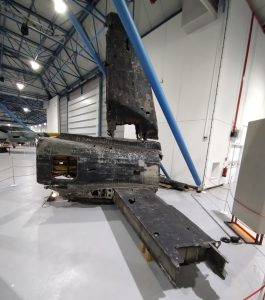The human memory is both wonderful and fragile. We can recall distant events in remarkable detail. We can also forget where we put the house keys the day before. A tangible reminder of an event or a person can be a powerful aid to memory.
When family history research reveals a connection to RAF service in WW2, it can help to see an example of the aircraft that features in the story. You are spoiled for choice if that aircraft was a Spitfire. Over 200 exist around the world with 50-60 in an airworthy condition. More often, we must rely on fragments.
 No complete Handley Page Halifax (a heavy bomber) survives from over 6000 manufactured. The one on display at the Yorkshire Air Museum is a composite with parts from many different aircraft. The example at the RAF Museum at Hendon was recovered from a lake in Norway and has been preserved ‘as found’. It is particularly evocative. (Pictured) (The crew all survived the crash landing.)
No complete Handley Page Halifax (a heavy bomber) survives from over 6000 manufactured. The one on display at the Yorkshire Air Museum is a composite with parts from many different aircraft. The example at the RAF Museum at Hendon was recovered from a lake in Norway and has been preserved ‘as found’. It is particularly evocative. (Pictured) (The crew all survived the crash landing.)
 A group of enthusiasts is trying to reconstruct the forward fuselage of a Short Stirling (another heavy bomber). They have access to many original drawings. Only small parts remain from over 2300 manufactured. The photo (also taken at Hendon) shows part of the tail.
A group of enthusiasts is trying to reconstruct the forward fuselage of a Short Stirling (another heavy bomber). They have access to many original drawings. Only small parts remain from over 2300 manufactured. The photo (also taken at Hendon) shows part of the tail.
Parts from three Handley Page Hampdens (from over 1400) are in various state of restoration. All were recovered from crash sites. As with the Stirling, the result will be representative, but with an inevitable penalty in terms of authenticity.
11,000 Vickers Wellingtons were made. Just two remain in museums, a Mk I and a Mk X. Whilst both have had parts replaced, they have excellent provenance. Curiously, the example at Brooklands Museum was also pulled from a lake, just like the Halifax. Patrick’s son, William, died in a Mk IV. Parts of a Mk IV were salvaged from a beach on the Isle of Lewis (off the North West coast of Scotland) in 2002 having been buried in the sand for over 50 years. There are plans to undertake a partial restoration of the front fuselage. The main difference between most of the Marks lies with the powerplants installed, so it is not immediately obvious what will be gained recreating another front fuselage.
Ironically, if the current passion for preserving and restoring aircraft had taken hold much earlier there would be many examples on display at museums. Perfectly serviceable, airworthy aircraft were sent to be scrapped in their hundreds after the end of the war. Enthusiasts are now required to scour crash sites, old farm buildings, and the bottom of lakes.
